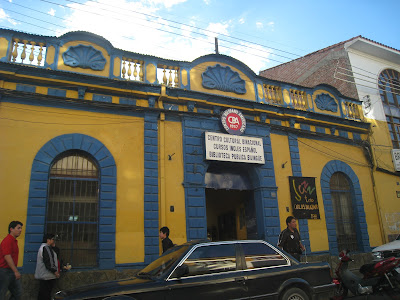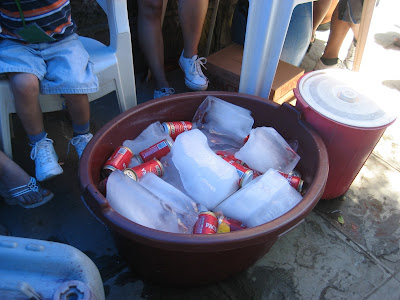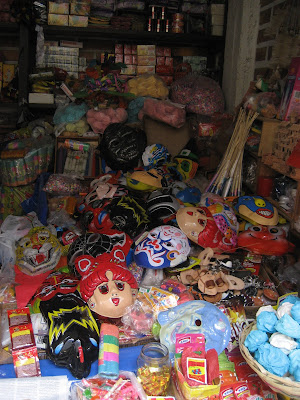(noun)
1. the berrylike fruit of either of two African shrubs that, when chewed, causes sour substances to taste sweet.
2. an old-fashioned blog started in 2008 that celebrates world travel and the adventure of life.
(This is what blogs looked like in 2008, and it hasn't changed since.)
29 April 2011
28 April 2011
25 April 2011
22 April 2011
tree in the road
I fell in love with this tree I saw in the middle of the road in Cochabamba, and I'm happy they didn't cut it down, that it just became a part of the road. When my partner and I walked by, kids were skateboarding around it, and it made me smile.
Often, it isn't the crazy "exotic" things you see while traveling but the simple things that leave an impression.
Have a great weekend, and for those of you that celebrate Easter, Happy Easter!
19 April 2011
from berkeley to bolivia
The way my partner's family ended up in Cochabamba is a good example of our making plans and life laughing at those plans. And how, often by being all Tao and going with the flow, we end up exactly where we belong.
So, let's go back to Berkeley circa the hippie '70s. Enter a pretty young Southern Californian ESL teacher and a spirited Bolivian musician. It isn't long before they're married and driving their VW van from Berkeley all the way down to the southern tip of Argentina for their yearlong honeymoon. On their way back through Bolivia, they decide they will raise their future kids there.
18 April 2011
cochabamba, bolivia
Cochabamba is in the heart of Bolivia, which is in the heart of South America, so one could argue that Cochabama is the heart of South America. But it is called the breadbasket of Bolivia and is more of a mellow little city than would really fit the 'heart of South America.'
In any case, Cochabamba is special to me because my partner grew up there from age four to eighteen, and I was thrilled to spend some time there and see his old house, his old school, meet old friends and family, etc. And it was charming in its own right.
The cuñapes (cheese-filled bread in a mochi-like rice-based dough) are delicious!
And go nicely with this concoction: shot of espresso with sweetened condensed milk. Decadent and guaranteed to keep you bouncing off the walls-- until you crash from the sugar high.
15 April 2011
little living spaces
 |
| via |
Anyway, here is a neat compilation of tiny and cool living spaces in a contest aptly called the Smallest Coolest Home Contest. One of my favorites from New York (of course): 397 square feet of awesome exposed brick walls, high ceilings and tall windows.
 |
| via |
I also love this one, which has 360 square feet:
 |
| via |
14 April 2011
a new room with a view
When we lived in Cambridge, we had a beautiful view out of our window of the Charles River and New England's amazing four seasons. Now that we're in California, we don't have quite the same dramatic changes, but it's still nice to see the colors of the hills around us change.


13 April 2011
the world through a little lens
the world through a little lens (This preview shows 14 of the 40 pages.)
I'm still over a year (and several continents) behind in going through my travel photos, but I've compiled a photo book that I hope you'll enjoy.
(NB: I'm not getting a penny from these, as I'm trying to help raise some money for two of my friends' nonprofits-- and I'd be happy to support any of your fundraising efforts, too, if you think I can be helpful.)
Book intro:
This is a simple tribute to the little digital camera. While fancy cameras keep adding impressive zooms and megapixels, sometimes, when all you want is a memory preserved, an idiot-proof point-and-shoot is just the answer.
All of the following photos were taken with a standard pocket camera, and none of them have been enhanced in any way, in the hope that their natural beauty will shine through, imperfections and all.
So, here's to the little guy that braved hail in the Falkland Islands, trekked across the Sahara on camelback, tramped up a glacier in New Zealand and dove down over 100 feet into the seas of Indonesia and never let me down. I hope you enjoy seeing the world through its little lens.
Blurb for good:
Proceeds from the sales of this photo book will go to support Grizzly Youth Academy (http://ngycp.org/site/state/ca/), a rigorous National Guard/SLO education partnership program that gives troubled youth the discipline and confidence to start healthy and productive lives, and Alpha, a nonprofit committed to helping and supporting expecting and new parents and babies (http://www.sloalpha.org/).
So, spread the word-- it's for a good cause!
12 April 2011
flight from tarija to cochabamba, bolivia
From Tarija, we flew to Cochabamba, where my partner grew up from age four to age eighteen, and I was thrilled to finally see it.
I love how Bolivia's airports allow friends and family to hang out over a balcony and wave as you walk to your plane.
We waved goodbye to the pope (well, he waved goodbye to us-- I'm not sure if we really waved back).
We flew away from the tiny airport of Tarija:
Flew pretty low, as most of Bolivia is already some 9000 feet above sea level.
We approached Cochabamba and saw its tan-colored lake.
And finally landed at Aeropuerto Jorge Wilstermann, an amusing sign of the German influence in the area.
We made our way across the tarmac, and my partner marveled at how this dinky airport was actually the new and improved one. "You should have seen the one we had growing up." Funny how that always seems to happen.
Next up: Cochabamba, Bolivia.
07 April 2011
hearing about kindness begets more kindness
 |
| via |
"Our study indicates that if more attention was devoted to recounting stories of uncommon acts of human virtue, the media could have a quantifiable positive effect on the moral behaviour of a significant group of people," said Aquino, a professor at the Sauder School of Business at UBC.But good news alone wouldn't suffice-- to really create that yearning to do something good, people have to read about really extraordinary deeds.
"These things have to be beyond just everyday goodness," Aquino said in an interview. "We help our neighbours all the time, we volunteer for things — we're talking here about really exceptional acts of virtue... Acts that require enormous sacrifice, that put people at risk for the sake of others."
So, here's an example of a good deed. You can see if you feel inclined to donate to charity (the variable measured in the Canadian studies) or do something to help someone else.
 |
| via |
Ten-year-old Cliff Forrest googled former NFL player, William "Refrigerator" Perry, and discovered that he'd had to sell his Super Bowl XX ring because he'd had health problems and had fallen on tough times.
So, unlike most ten-year-old kids, Forrest decided to take $8500 out of his college fund and buy the ring and give it back to Perry.
 |
| via |
06 April 2011
dare to be an optimist
 Need more good news? (Who doesn't?) Here is an article on why there has never been a better time to be alive.
Need more good news? (Who doesn't?) Here is an article on why there has never been a better time to be alive.From Matt Ridley, British author of The Rational Optimist:
For the past month, the news has been all bad - war, recession, riot, tsunami, earthquake, nuclear disaster, inflation, cuts... and the cricket.
But while the news is always bad, there has never been a better time to be alive.
The average citizen of earth is wealthier, healthier, wiser, cleaner, cleverer, kinder, more peaceful, more equal, freer and happier than ever before.
Average lifespan is increasing across the globe at the rate of five hours per day. Child mortality has fallen by two thirds in 50 years.
IQ scores are rising all around the world.
London's air and Britain's rivers have never been so free of pollution.
Charitable donations are at unprecedented levels.
The last decade saw the lowest number of deaths in war since 1945 worldwide.
Inequality is falling as poor countries such as India, Brazil and Botswana get rich faster than rich countries such as Britain, America and Japan.
Freedom is on the march - the Russian empire fell, the Chinese liberalised, South American juntas collapsed, Arab despots are toppling.
Soon only a few tyrants will be left - Kim Jong-il, Castro, Chavez, Ahmadinejad, whoever runs Burma and a clutch of increasingly worried African despots in silly uniforms.
And, yes, even happiness goes up as people get richer.
It is easier to be happy when you don't face death, dirt, disease and a long-drop toilet. The average British working man in 1957 - the year Harold Macmillan told us we had "never had it so good" - earned less than a modern father of three gets in state benefits (after correcting for inflation).
In the Fifties it took 30 minutes to earn the price of a hamburger on the average wage.
Today it takes three minutes.
A modern car emits 95 per cent less carbon monoxide, nitrogen oxides and hydrocarbons than it did in the Seventies.
The fatal accident rate of air travel was 13 times higher in 1969 than it was in 2009. The death rate from heart attacks and strokes at any given age has halved since 1970.
I lay out these statistics in my book The Rational Optimist: How Prosperity Evolves.
When I was young, nobody told me any of this.
They said Britain was in decline, the world was running out of oil, the population explosion was unstoppable, global famine was inevitable, an epidemic of cancer caused by pesticides was going to shorten all our lives, nuclear war was coming, the desert was advancing at a mile a year, acid rain was destroying the forests, the ozone layer was shrinking and my sperm count was going to fall.
Yet all the time, inexorably - and unheralded in the news - things were inching better.
New ideas and new technologies were being invented to reduce the time each of us takes to fulfil a need or a wish.
All it takes to improve living standards is to make sure energy is cheap and let people work for each other through trade, to let ideas meet and mate - and innovation follows.
Good as life is compared with the past, the future is going to be much better.
For 200 years living standards have been accelerating upwards because trade and communication have been getting easier.
On present trends the average citizen of earth will be at least twice as rich as the average American is today by 2100 - corrected for inflation.
Yet thanks to the internet, innovation has accelerated.
There will still be wars and natural disasters.
But consider this - your probability of death from a storm, flood or drought was 98 per cent lower in the last decade than it was in the Twenties.
05 April 2011
tarija, bolivia
Back to our travels! After crossing from Argentina into Bolivia, Tarija was our first destination. It's known for its grapes and wines and for its "southern" accent. (The Spanish here really was the equivalent of American English in the south-- with more of a drawl and harder for me as a beginner to understand.)
From the border, we passed through a few small towns and lots of open landscape.
 |
| random donkey |
We arrived during their annual harvest festival, and we got to see the tail end of the girls' parade and part of the boys' parade through town.
There were girls and boys on llamas, donkeys and horses going by, but I thought the boy carrying the (live) sheep on his shoulders was an interesting addition I'd never seen before.
Long green grasses were everywhere, symbolizing the harvest, as well as colorful little balloons. Everything was decked out, including strollers and remote-control cars.
Music was also different than your usual parade fare. Men played actual animal horns and drums.
And I guess the older kids got bored with the cowboy/rancher costumes and decided to do their own thing.
After the parade, there was a little beauty pageant for the girls.
And the boys (and some girls) had all-out water-gun and water-balloon wars.
Apparently, the water fights are a very crucial part of the Bolivian Carnival experience, and my partner told me that when he was growing up, his dad would drive him and his siblings around town in their truck while they threw water balloons at other people. The rule was that you only attacked those playing, but attractive girls would often get pelted, too, just to get their attention.
As for the adults, the post-parade experience was comprised of barbecues/food stands, music and lots of drinking.
These baskets were everywhere, full of fruits, vegetables, cookies and pastries, and decorated with colorful streamers, flags and balloons, and it looked like everyone was giving them to everyone.
Accordingly, the gift basket business was thriving in Tarija.
I loved Tarija's markets, in general.
I often find fruit displays really beautiful, even a simple one of just apples and grapes.
Tarija is also known for these giant flat, round loaves of bread. They're sort of like a denser pita bread.
My favorite thing to eat in all of Bolivia: salteñas. They're like giant dumplings but with a baked, almost cakey crust and a chicken or beef stew inside. Usually eaten for breakfast, I'd be happy to eat them anytime of day. Yum!
And we found Tarija to be a lovely little city to walk around, too.
As always when we travel, we enjoyed seeing slices of local life. Kids were playing in the fountain in the main park, the rows of red shoeshine stands were always full, and there were lots of neat old cars.
It's funny-- just like in Africa, the buses had the most unexpected names.
And I don't think I've ever been anywhere in the world where there wasn't at least one Chinese shop or restaurant. Though a churrasqueria named Jackie Chan may be a first.

It was nice for me to see my birthday celebrated as a main street and the name of a pharmacy, too.
Here's something you probably wouldn't want to get there, though:
On a heavier note, we got to see where my partner's grandmother was buried. Surrounding what I'm used to seeing as a cemetery (tombs on the ground), there were walls of tombs, too.
You could either have the smaller ones:
Or the larger ones with doors:
It's funny. When I'm traveling, I find even the sky looks different from home sometimes.
It's also funny to see which places end up on the international clocks. I think this may be the only place in the world you'd see Tokyo, London, Tarija, Madrid and Miami.
The pope came to Tarija a while back, so you get to see a giant pope welcoming you when you fly in or waving you off as you fly out.
Subscribe to:
Posts (Atom)








































































































